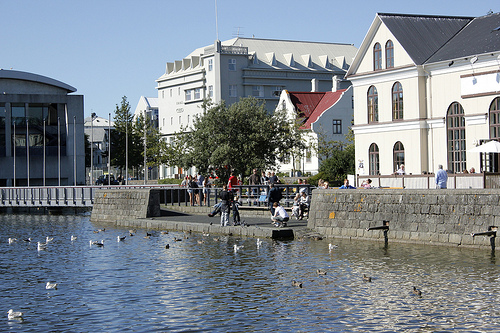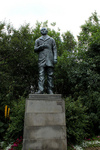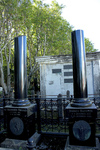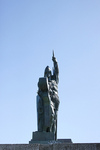There are many sculptures and attempts at public art strewn over Reykjavík. Most of the time we don’t notice them, blinded by the familiar surroundings of our day to day. We should stop and look every now and again. A lot of them are beautiful, and almost every one of them has an interesting story that goes with it. To encourage this, we made you up a short walk which should take about 40–50 minutes of your time. In the walk, we focus exclusively on the work of fabled sculptor Einar Jónsson (1874–1954), who is one of Iceland’s most celebrated artists and is responsible for some groundbreaking sculptures. Do read on, and get to know some of the stern- faced green figures dotting our urban landscape, and why they are there.
1.
 This is a pretty good spot to start. If it is a nice day there will be some people feeding the ducks and if you have some bread you could do that too. The ducks sure seem to appreciate it. Afterwards head on up Fríkirkjuvegur alongside the pond.
This is a pretty good spot to start. If it is a nice day there will be some people feeding the ducks and if you have some bread you could do that too. The ducks sure seem to appreciate it. Afterwards head on up Fríkirkjuvegur alongside the pond.
2.
 At our first stop we find Icelandic poet Jónas Hallgrímsson. Jónas was a prolific writer with a keen interest in Icelandic nature, on which he wrote many studies. He passed away at the young age of 37 due to blood poisoning caused by a broken leg he sustained after slipping on the stairs at his home in Copenhagen. This depiction by Einar Jónsson was the first statue by an Icelandic artist to be erected in a public place. It was supposed to stand in front of where the Culture House (Þjóðmenningarhúsið) now stands, but because it was not finished at that time the statue was ‘temporarily’ placed at the corner of Amtmannstígur and Lækjargata in 1907. There it stood until 1947, when it was moved to this spot.
At our first stop we find Icelandic poet Jónas Hallgrímsson. Jónas was a prolific writer with a keen interest in Icelandic nature, on which he wrote many studies. He passed away at the young age of 37 due to blood poisoning caused by a broken leg he sustained after slipping on the stairs at his home in Copenhagen. This depiction by Einar Jónsson was the first statue by an Icelandic artist to be erected in a public place. It was supposed to stand in front of where the Culture House (Þjóðmenningarhúsið) now stands, but because it was not finished at that time the statue was ‘temporarily’ placed at the corner of Amtmannstígur and Lækjargata in 1907. There it stood until 1947, when it was moved to this spot.
Einar was never happy with this statue, because he was forced to make a ‘lifelike’ depiction of Jónas by the men who were paying for it. He thought he could just as well be making the man’s shoes as making him a monument in this manner. He wanted to do something that would symbolise the admired man and his work, and much later on, in 1948, he made another statue of Jónas Hallgrímsson called ‘In the memory of the poet’, which can be viewed at his museum.
It is worth mentioning that further into the garden stands the self-portrait of famed Danish sculptor Bertel Thorvaldsen. Even though he never set foot on Icelandic soil, he is often regarded an Icelander as he had an Icelandic father. This statue was a gift from the city of Copenhagen in 1874 to commemorate Iceland’s settlement one thousand years earlier. It stood in the middle of Austurvöllur before being moved here, where almost no one sees it.
3.
 Overlooking the pond is ‘The Spell Broken’. Many connect it to the legend of St. George and the dragon, where St. George slew the dragon so he could save the princess from being eaten by it. In fact it is a mixture of a few old legends. Einar sometimes took pieces from different folk tales and religious fables and pieced them together to fit what he wanted to say. It depicts the victory of good over evil, and the rewards that follow when you choose the right path. Here the young woman is freed from an evil spell when the dragon is slain. She sheds the skin of the old crone she was cursed to look like and revealed is her beautiful true form. The statue was unveiled here in 1987.
Overlooking the pond is ‘The Spell Broken’. Many connect it to the legend of St. George and the dragon, where St. George slew the dragon so he could save the princess from being eaten by it. In fact it is a mixture of a few old legends. Einar sometimes took pieces from different folk tales and religious fables and pieced them together to fit what he wanted to say. It depicts the victory of good over evil, and the rewards that follow when you choose the right path. Here the young woman is freed from an evil spell when the dragon is slain. She sheds the skin of the old crone she was cursed to look like and revealed is her beautiful true form. The statue was unveiled here in 1987.
4.
 ‘Outlaws’ is one of Einar Jónsson’s most famous works and one that many Icelanders identify with: the free spirit who does not walk the beaten path. Einar here draws inspiration from the old folktales of ‘the outlaw’ condemned to a hard life of solitude and isolation. Here he may be seen carrying his dead wife down from the highland so that he can bury her in hallowed ground. There is a quiet sadness in the strong look on his face as he does what has to be done, while carrying his only child in his other arm. This was the first piece Einar showed publicly, and was unveiled in Copenhagen in 1901. It got mixed reviews from the Danes but the Icelandic people were thrilled and thought Einar had captured the spirit of the Icelandic people. Once this statue of the outlaw looked mournfully to the mountains—now he just watches the national library and is partially hidden by trees.
‘Outlaws’ is one of Einar Jónsson’s most famous works and one that many Icelanders identify with: the free spirit who does not walk the beaten path. Einar here draws inspiration from the old folktales of ‘the outlaw’ condemned to a hard life of solitude and isolation. Here he may be seen carrying his dead wife down from the highland so that he can bury her in hallowed ground. There is a quiet sadness in the strong look on his face as he does what has to be done, while carrying his only child in his other arm. This was the first piece Einar showed publicly, and was unveiled in Copenhagen in 1901. It got mixed reviews from the Danes but the Icelandic people were thrilled and thought Einar had captured the spirit of the Icelandic people. Once this statue of the outlaw looked mournfully to the mountains—now he just watches the national library and is partially hidden by trees.
5.
 Hólavalla cemetery was ready for its first occupants in the summer of 1837 but the first person was not laid to rest there until the winter of 1838. There were two main reasons for the delay. There is an old folktale that says that the first person buried in a cemetery becomes its watcher. This person does not rot and its purpose is to watch over the garden and welcome everyone that will be buried there. People in general want their relatives to rest in peace, so very few wanted to nominate their loved one to become the watcher. In the Einar Jónsson museum, you can find a statue named ‘The Watcher’ which is inspired by this folktale. The other reason was that church officials did not want just anyone to be the first person buried in the cemetery, so even though quite a few people died that year, and the cemetery stood empty, it was deemed that none of them were of the right standing to be its first patron. Finally, the lady Guðrún Oddsdóttir was deemed worthy enough, she and her family were considered to be in good standing in Reykjavík and her grave is marked by the largest iron cross in the cemetery—maybe you can find it?
Hólavalla cemetery was ready for its first occupants in the summer of 1837 but the first person was not laid to rest there until the winter of 1838. There were two main reasons for the delay. There is an old folktale that says that the first person buried in a cemetery becomes its watcher. This person does not rot and its purpose is to watch over the garden and welcome everyone that will be buried there. People in general want their relatives to rest in peace, so very few wanted to nominate their loved one to become the watcher. In the Einar Jónsson museum, you can find a statue named ‘The Watcher’ which is inspired by this folktale. The other reason was that church officials did not want just anyone to be the first person buried in the cemetery, so even though quite a few people died that year, and the cemetery stood empty, it was deemed that none of them were of the right standing to be its first patron. Finally, the lady Guðrún Oddsdóttir was deemed worthy enough, she and her family were considered to be in good standing in Reykjavík and her grave is marked by the largest iron cross in the cemetery—maybe you can find it?
Hólavalla cemetery is a beautiful, serene spot in the city, it is very interesting to walk through, and there are many hidden gems of art on the headstones. A few of them are by Einar Jónsson, three of which are very close to each other. They are ‘Come to me’ and ‘Morgunroðinn’ on the gravestones of Hannes Hafstein and his wife Ragnheiður Hafstein. Look for graves marked with two broken black marble pillars. Hannes was a poet and the first Icelandic minister. Einar also made a statue of him, which you will observe later on this walk. The third is the gravestone of Þorsteinn Erlingsson and his wife Guðrún. Þorsteinn was a journalist and a poet. He could be called radical, often writing against norms and traditions that he thought were hampering the Icelandic nation. Einar designed the shape of the stone, which seems to depict either a candle or a tear. On it is a small bronze plate, which shows a scene similar to another work of Einar called ‘Brautryðjandinn’ which can be seen later on the pedestal of Jón Sigurðsson. Þorsteinn was a dear friend of Einar and died at a relatively young age, so it comes as no surprise that Einar would have wanted to show his respect in this way.
6.
 Here stands Jón Sigurðsson, with his head held up high and his back straight as an arrow, watching the parliament building. Jón Sigurðsson was a pioneer in Iceland’s struggle for independence. This statue originally stood in front of the government offices and was unveiled there in 1911. In 1931 it was moved here to replace the aforementioned Bertel Thorvaldsen self-portrait. Note the smaller work on the pedestal, it is called ‘The pioneer’, and it depicts how Einar viewed Jón and how he wanted him to be remembered; as a strong pioneer who paved the way for the rest of us. It was a gift from Einar Jónsson, one which allowed him to look past the fact that he was once again forced to do go against his artistic vision and make a lifelike statue. Einar never liked this pedestal they placed Jón on. He reportedly always thought the statue looked like it was leaning backwards, like it was falling. What do you think?
Here stands Jón Sigurðsson, with his head held up high and his back straight as an arrow, watching the parliament building. Jón Sigurðsson was a pioneer in Iceland’s struggle for independence. This statue originally stood in front of the government offices and was unveiled there in 1911. In 1931 it was moved here to replace the aforementioned Bertel Thorvaldsen self-portrait. Note the smaller work on the pedestal, it is called ‘The pioneer’, and it depicts how Einar viewed Jón and how he wanted him to be remembered; as a strong pioneer who paved the way for the rest of us. It was a gift from Einar Jónsson, one which allowed him to look past the fact that he was once again forced to do go against his artistic vision and make a lifelike statue. Einar never liked this pedestal they placed Jón on. He reportedly always thought the statue looked like it was leaning backwards, like it was falling. What do you think?
7.
 Two statues by Einar stand here in front of the government offices, the one to the left is King Christian the 9th of Denmark (and Iceland at the time), holding a rolled up piece of paper which is supposed to be the first Icelandic constitution. Einar finished this statue in 1907, but it was not unveiled here until 1915 due to Icelanders’ prevalently ambivalent attitude about erecting the king of Denmark a memorial. This was when Iceland was still trying to gain more independence from Denmark, so praising the king seemed a little contradictory to some.
Two statues by Einar stand here in front of the government offices, the one to the left is King Christian the 9th of Denmark (and Iceland at the time), holding a rolled up piece of paper which is supposed to be the first Icelandic constitution. Einar finished this statue in 1907, but it was not unveiled here until 1915 due to Icelanders’ prevalently ambivalent attitude about erecting the king of Denmark a memorial. This was when Iceland was still trying to gain more independence from Denmark, so praising the king seemed a little contradictory to some.
The statue on the right depicts Hannes Hafstein, whose grave you will have stopped by if you are following our map. He was the first Icelandic Minister and a poet. He was actually a damn good poet; look up the poem ‘Stormur’ (“Storm”) for conclusive proof of that. Hannes was one of the men that paved the way for Einar Jónsson’s art education, by agreeing in congress to grant him a sizeable amount of money so he could pursue his studies abroad. Einar would have felt honoured to be able to repay the favour in this way. Another thing of note is that this is actually the pedestal on which the statue of Jón Sigurðsson stood first, if you remember the shape of ‘The Pioneer’ you will notice that the shield on which Hannes Hafstein’s name is on is in the same shape as ‘The Pioneer’. Jón Sigurðsson and ‘The Pioneer’ were both moved over to Austurvöllur when the statue of Hannes Hafstein was put here in 1931.
8.
 The Icelandic Craftsman Association (ATH – Iðnaðarmannafélagið) in Reykjavik donated money and held fund raising events so that a memorial to Ingólfur Arnarson (who was the first Icelandic settler, as legend would have it) could be raised on Arnarhóll. Einar had actually started working on a statue of Ingólfur before being approached by the association. He even wrote in a letter to a friend in 1902 that he would want it erected on Arnarhóll. Because of difficulties raising funds and problems between the Craftsman association and Einar, the statue was not unveiled until 1924. The whole process took around 22 years. The committee from the association was happy with the statue of Ingólfur himself, but they had a big problem with the four reliefs Einar wanted to accompany the statue. They depicted scenes which the committee thought were offensive and had in fact nothing to do with the strong Viking man Ingólfur was supposed to have been. Einar wanted to show the story of why Ingólfur chose to come to Iceland, the committee especially disliked the sentence “You should lead yourself,” or “Sjálfur leið þú sjálfan þig”—words that Einar thought defined what Ingólfur was all about. The men in the committee thought this was too radical and went against what the Old Icelandic sagas said about Ingólfur. So the statue was raised without the reliefs or the pedestal Einar had designed. Einar himself did not show up to the unveiling. The statue is often used as a kind of a logo for Reykjavík.
The Icelandic Craftsman Association (ATH – Iðnaðarmannafélagið) in Reykjavik donated money and held fund raising events so that a memorial to Ingólfur Arnarson (who was the first Icelandic settler, as legend would have it) could be raised on Arnarhóll. Einar had actually started working on a statue of Ingólfur before being approached by the association. He even wrote in a letter to a friend in 1902 that he would want it erected on Arnarhóll. Because of difficulties raising funds and problems between the Craftsman association and Einar, the statue was not unveiled until 1924. The whole process took around 22 years. The committee from the association was happy with the statue of Ingólfur himself, but they had a big problem with the four reliefs Einar wanted to accompany the statue. They depicted scenes which the committee thought were offensive and had in fact nothing to do with the strong Viking man Ingólfur was supposed to have been. Einar wanted to show the story of why Ingólfur chose to come to Iceland, the committee especially disliked the sentence “You should lead yourself,” or “Sjálfur leið þú sjálfan þig”—words that Einar thought defined what Ingólfur was all about. The men in the committee thought this was too radical and went against what the Old Icelandic sagas said about Ingólfur. So the statue was raised without the reliefs or the pedestal Einar had designed. Einar himself did not show up to the unveiling. The statue is often used as a kind of a logo for Reykjavík.
9.
The Culture House was built to house the national library and national archives of Iceland, the National Museum and Natural History Museum were also housed there for some time, and it became known as the Museum Building. It is one of the most beautiful buildings in Reykjavík and is mentioned here because the statues of Jónas Hallgrímsson and Jón Sigurðsson were originally supposed to stand in front of it. Today it houses a permanent exhibition of Old Icelandic manuscripts that are very much worth a look.
10.
 This is the final stop, the home and studio of the sculptor Einar Jónsson, built for him by the Icelandic state after he donated all of his work to the people of Icelandic. The house was designed by Einar himself in collaboration with the architect Einar Erlendsson and is sometimes said to be his biggest sculpture. It was given the name Hnitbjörg by some of Einar’s friends. Hnitbjörg in Norse mythology is where the poetic mead was kept and Einar was sometimes referred to as the poet sculptor. The museum first opened its doors to the public in 1923 and has welcomed guests ever since. A good place to start is the sculpture garden behind the museum, which contains quite a few examples of Einar’s work in bronze. The museum itself contains around 300 works of art made by Einar in his lifetime as well as his studio and living quarters in their original state.
This is the final stop, the home and studio of the sculptor Einar Jónsson, built for him by the Icelandic state after he donated all of his work to the people of Icelandic. The house was designed by Einar himself in collaboration with the architect Einar Erlendsson and is sometimes said to be his biggest sculpture. It was given the name Hnitbjörg by some of Einar’s friends. Hnitbjörg in Norse mythology is where the poetic mead was kept and Einar was sometimes referred to as the poet sculptor. The museum first opened its doors to the public in 1923 and has welcomed guests ever since. A good place to start is the sculpture garden behind the museum, which contains quite a few examples of Einar’s work in bronze. The museum itself contains around 300 works of art made by Einar in his lifetime as well as his studio and living quarters in their original state.
Buy subscriptions, t-shirts and more from our shop right here!

















